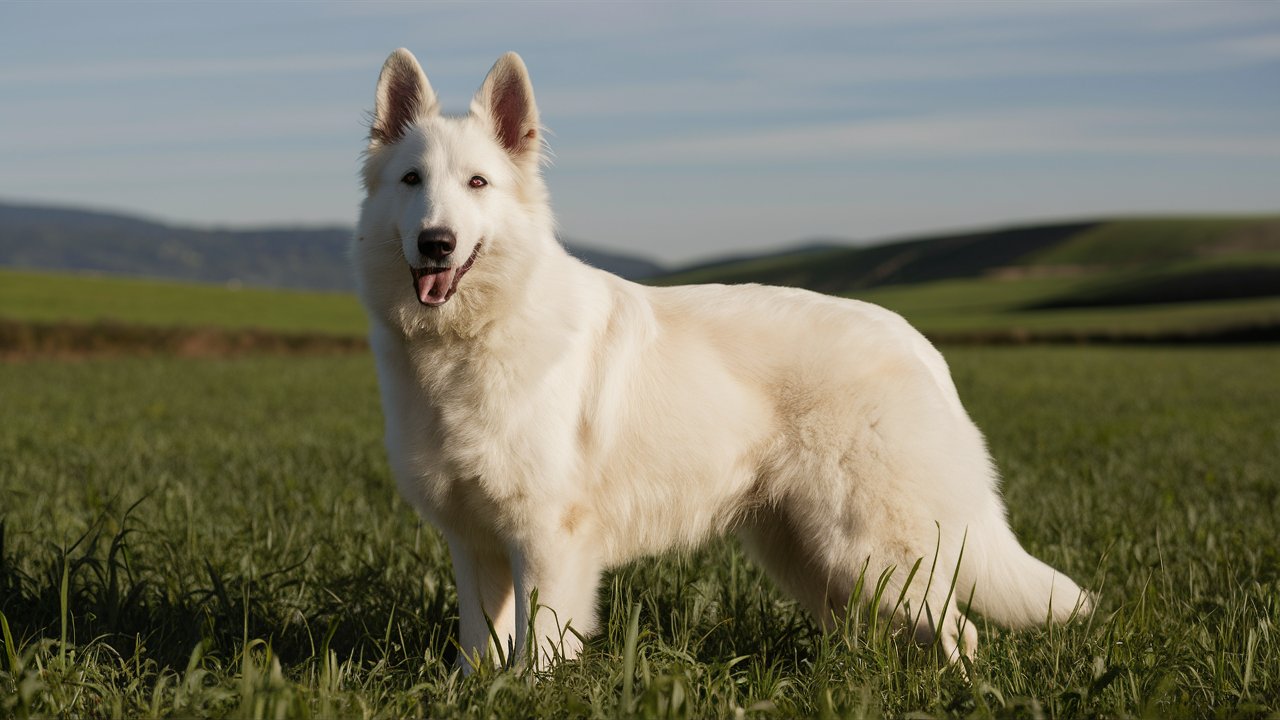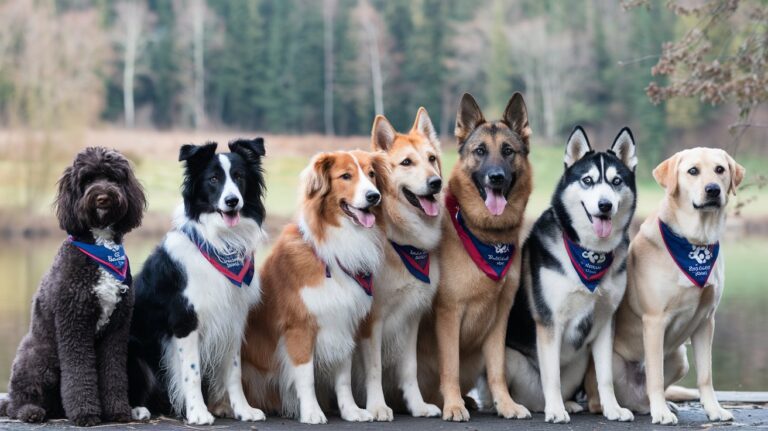White Shepherd: 100% Loyal and Comprehensive Guardian
The White Shepherd, a strikingly beautiful and intelligent breed, has captivated dog enthusiasts worldwide with its loyalty, versatility, and distinctive appearance. While closely related to the German Shepherd, the White Shepherd stands out not only for its unique white coat but also for its gentle and friendly demeanor. In this article, we will delve into the history, characteristics, training, and care of the White Shepherd, exploring why this breed might be the perfect addition to your family.
History and Origins

The White Shepherd’s origins are intertwined with those of the German Shepherd. The breed’s history dates back to the late 19th and early 20th centuries in Germany. Max von Stephanitz, a German cavalry officer, is credited with developing the German Shepherd Dog (GSD) by selectively breeding herding dogs for their working ability, intelligence, and loyalty. Among the early GSDs, white-coated dogs occasionally appeared, but they were not favored by the breed’s standard at the time.
The white coat was viewed as a fault, and in the mid-20th century, white-coated German Shepherds were excluded from the breed standard in both Germany and the United States. However, enthusiasts who appreciated the beauty and unique qualities of these white dogs continued to breed them. Over time, these dedicated breeders worked to establish the White Shepherd as a distinct breed, separate from the traditional German Shepherd.
Characteristics and Appearance
The White Shepherd is a medium to large-sized dog, typically weighing between 50 and 85 pounds and standing 22 to 26 inches tall at the shoulder. The breed’s most distinguishing feature is its pure white coat, which is dense, double-layered, and weather-resistant. The coat can be either short or long, with both varieties requiring regular grooming to keep it in top condition.
White Shepherds have a strong, athletic build, with a straight back, well-muscled limbs, and a bushy tail. Their ears are erect and pointed, giving them an alert and attentive expression. Their eyes are almond-shaped and can be dark brown or amber, exuding intelligence and warmth.
Temperament and Personality
One of the most appealing aspects of the White Shepherd is its temperament. These dogs are known for their loyalty, intelligence, and gentle nature. They are highly trainable and eager to please, making them excellent companions for families, singles, and seniors alike. White Shepherds are known to form strong bonds with their owners and are often described as “velcro dogs” because they love to stay close to their human family members.
Personal Anecdote: I remember when I first adopted my White Shepherd, Luna. She quickly became my shadow, following me from room to room and always seeking to be part of whatever I was doing. Her gentle and loving nature made her an instant hit with my children, who adore her as their playmate and protector.
White Shepherds are also known for their versatility. They excel in various roles, including therapy work, search and rescue, and as service dogs for individuals with disabilities. Their keen intelligence and strong work ethic make them well-suited for these important tasks.
Training and Socialization
Training a White Shepherd can be a rewarding experience due to their intelligence and eagerness to learn. Early socialization and training are essential to ensure they grow into well-mannered and confident adults. Positive reinforcement techniques, such as treats, praise, and play, work best with this breed.
It’s important to expose White Shepherds to various environments, people, and other animals from a young age. This helps them develop into well-rounded dogs who are comfortable and confident in different situations. Puppy classes and obedience training can provide valuable socialization opportunities and lay the foundation for good behavior.
Exercise and Activity Needs
White Shepherds are active dogs that require regular exercise to keep them physically and mentally stimulated. Daily walks, playtime in a securely fenced yard, and interactive toys can help meet their exercise needs. They also enjoy activities such as hiking, running, and agility training.
Personal Anecdote: Luna’s favorite activity is playing fetch at the local park. She loves to sprint across the field, her white coat gleaming in the sunlight as she eagerly retrieves the ball. It’s not only great exercise for her but also a wonderful bonding experience for us.
Health and Care
The White Shepherd is generally a healthy and robust breed, but like all dogs, it can be prone to certain health issues. Understanding these potential concerns and knowing how to care for your White Shepherd can help ensure a long, healthy, and happy life for your canine companion.
Common Health Issues
- Hip Dysplasia: This is a genetic condition where the hip joint does not fit into the hip socket properly. It can lead to arthritis and discomfort. Ensuring your White Shepherd’s parents have been screened for hip dysplasia can reduce the risk. Maintaining a healthy weight and providing appropriate exercise can also help manage this condition.
- Elbow Dysplasia: Similar to hip dysplasia, elbow dysplasia involves malformation of the elbow joint, leading to pain and arthritis. Responsible breeding practices and maintaining good joint health can help mitigate this risk.
- Degenerative Myelopathy: This is a progressive disease of the spinal cord, similar to ALS in humans. It typically affects older dogs and leads to hind limb weakness and paralysis. While there is no cure, supportive care and physical therapy can help manage symptoms and improve quality of life.
- Exocrine Pancreatic Insufficiency (EPI): EPI is a condition where the pancreas does not produce enough digestive enzymes, leading to malabsorption and malnutrition. It can be managed with enzyme supplements and a special diet.
- Allergies: White Shepherds can be prone to allergies, including food allergies, environmental allergies, and contact allergies. Symptoms can include itching, ear infections, and gastrointestinal issues. Identifying and avoiding allergens and working with a veterinarian to develop a management plan is essential.
Regular Veterinary Care
Regular veterinary check-ups are crucial for maintaining your White Shepherd’s health. Annual or biannual visits allow for early detection of potential health issues and ensure that your dog stays up-to-date on vaccinations, parasite prevention, and dental care. Key aspects of regular veterinary care include:
- Vaccinations: Keeping your White Shepherd vaccinated against common canine diseases, such as rabies, distemper, parvovirus, and kennel cough, is vital for their health and the health of other dogs they may come into contact with.
- Parasite Prevention: Regular treatment for fleas, ticks, and heartworms is essential to prevent infestations and the diseases they can transmit.
- Dental Care: Dental health is often overlooked, but it’s crucial for your dog’s overall well-being. Regular brushing, dental chews, and professional cleanings can help prevent dental disease.
Nutrition
A balanced diet is fundamental to your White Shepherd’s health. High-quality commercial dog food that meets the nutritional standards set by the Association of American Feed Control Officials (AAFCO) is generally recommended. Key points to consider include:
- Protein: Ensure the food contains high-quality animal-based protein sources. Protein is essential for muscle development and overall health.
- Fats: Healthy fats provide energy and support skin and coat health. Look for foods with omega-3 and omega-6 fatty acids.
- Carbohydrates: While dogs are primarily carnivores, carbohydrates can provide a source of energy. Ensure they come from high-quality sources like sweet potatoes and brown rice.
- Vitamins and Minerals: A well-balanced diet should include all necessary vitamins and minerals. Supplementation is usually not needed if you are feeding a high-quality commercial diet.
Always consult your veterinarian before making significant changes to your dog’s diet, especially if they have specific health conditions or dietary needs.
Exercise and Mental Stimulation

White Shepherds are active and intelligent dogs that require regular physical and mental exercise to stay healthy and happy. A well-exercised dog is less likely to develop behavioral issues. Key considerations include:
- Daily Exercise: Aim for at least an hour of exercise daily. This can include walks, runs, playtime, and off-leash activities in a secure area.
- Mental Stimulation: Provide mental challenges through puzzle toys, training sessions, and interactive games. White Shepherds thrive on mental stimulation and enjoy learning new commands and tricks.
- Socialization: Regular interaction with other dogs and people is important for your White Shepherd’s social development. Arrange playdates, attend dog parks, and participate in group training classes to ensure your dog remains well-socialized.
Grooming
The White Shepherd’s beautiful white coat requires regular grooming to keep it in top condition. Whether your dog has a short or long coat, consistent grooming practices are essential:
- Brushing: Brush your White Shepherd at least once a week to remove loose hair and prevent matting. During shedding seasons, which typically occur twice a year, more frequent brushing is necessary.
- Bathing: Bathe your White Shepherd as needed, but not too frequently, to avoid stripping the coat of its natural oils. Use a gentle dog shampoo and ensure thorough rinsing to prevent skin irritation.
- Nail Trimming: Regularly trim your dog’s nails to prevent overgrowth and discomfort. If you can hear your dog’s nails clicking on the floor, it’s time for a trim.
- Ear Cleaning: Check your dog’s ears regularly for signs of infection, such as redness, odor, or excessive wax buildup. Clean the ears with a veterinarian-recommended solution if necessary.
- Teeth Cleaning: Brush your dog’s teeth several times a week to prevent dental disease. Use a dog-specific toothbrush and toothpaste.
Creating a Safe and Comfortable Environment
Providing a safe and comfortable living environment is crucial for your White Shepherd’s well-being:
- Secure Yard: If you have a yard, ensure it is securely fenced to prevent your dog from escaping. White Shepherds are agile and can jump high, so the fence should be tall enough to deter any escape attempts.
- Shelter: Provide a comfortable indoor space where your dog can rest and feel secure. A cozy bed and a designated spot in your home can help your dog feel safe and part of the family.
- Toys and Enrichment: Keep a variety of toys and enrichment activities available to keep your dog entertained and mentally stimulated.
Finding a White Shepherd

Finding a White Shepherd that fits well with your lifestyle and preferences requires careful consideration and research. Whether you choose to go through a breeder or adopt, it’s important to make informed decisions to ensure you bring home a healthy and well-adjusted dog.
Reputable Breeders
Choosing a reputable breeder is crucial when looking for a White Shepherd. Here are some steps and tips to help you find a responsible breeder:
- Research and Referrals: Start by researching breeders who specialize in White Shepherds. You can find breeder directories through national and regional breed clubs, such as the American White Shepherd Association (AWSA) or the White Shepherd Club of America (WSCA). Additionally, attending dog shows and talking to current White Shepherd owners can provide valuable referrals.
- Breeder Credentials: Look for breeders who have a solid reputation and are well-regarded within the breeding community. A good breeder will be knowledgeable about the breed, its health issues, and breed standards. They should be transparent about their breeding practices and willing to answer all your questions.
- Health Testing: Ensure that the breeder conducts health tests on their breeding stock. This includes screening for common genetic conditions such as hip and elbow dysplasia, degenerative myelopathy, and other hereditary diseases. Ask for proof of health clearances for both the sire and dam.
- Visiting the Breeder: If possible, visit the breeder’s facility to see the living conditions of the dogs and puppies. The environment should be clean, safe, and well-maintained. Observe the temperament and behavior of the adult dogs, as they can be indicative of the puppies’ future demeanor.
- Puppy Socialization: A reputable breeder will start socializing the puppies from an early age, exposing them to various stimuli, sounds, and experiences. This early socialization is crucial for the puppies’ development and helps them become well-rounded adult dogs.
- Contracts and Guarantees: A responsible breeder will provide a written contract that includes health guarantees, spay/neuter agreements, and a return policy if you can no longer care for the dog. This demonstrates their commitment to the well-being of their dogs throughout their lives.
Adoption and Rescue
Adopting a White Shepherd can be a rewarding experience and gives a dog in need a second chance at a loving home. Here are some steps to consider when adopting:
- Rescue Organizations: Contact White Shepherd rescue organizations or general dog rescue groups that may have White Shepherds available for adoption. Organizations like AWSA and WSCA often have rescue divisions dedicated to rehoming White Shepherds.
- Shelters and Animal Control: Check local animal shelters and animal control facilities. While it may be less common to find a White Shepherd in these locations, it’s worth checking regularly and being on their waiting list.
- Adoption Events: Attend adoption events hosted by rescue groups and shelters. These events can be an opportunity to meet and interact with available dogs and speak with volunteers about the adoption process.
- Foster-to-Adopt Programs: Some rescue organizations offer foster-to-adopt programs, allowing you to foster a dog before making a permanent commitment. This can be a great way to ensure the dog is a good fit for your home and lifestyle.
- Application Process: Be prepared to go through an application process that may include interviews, home visits, and reference checks. This thorough process helps ensure that the dog is placed in a suitable and loving environment.
- Matching the Right Dog: Rescue organizations often have knowledgeable staff who can help match you with a dog that fits your lifestyle, experience level, and preferences. Be open and honest about your expectations and living situation to find the best match.
Additional Tips
- Be Patient: Finding the right White Shepherd, whether through a breeder or adoption, can take time. Be patient and avoid rushing into a decision. The right dog is worth the wait.
- Red Flags: Be wary of breeders or sellers who prioritize profit over the well-being of the dogs. Red flags include poor living conditions, lack of health testing, and reluctance to provide information or allow visits.
- Continued Support: A good breeder or rescue organization will offer continued support and advice even after you bring your White Shepherd home. They should be a resource for any questions or concerns you may have as your dog grows and matures.
By taking the time to thoroughly research and choose a reputable breeder or adopt from a responsible rescue organization, you can ensure that your new White Shepherd is a healthy, well-adjusted, and cherished member of your family.

Conclusion
The White Shepherd is a remarkable breed that combines beauty, intelligence, and a gentle nature. Their loyalty and versatility make them exceptional companions for a wide range of households. Whether you’re looking for a family pet, a working dog, or a loyal friend, the White Shepherd can be an excellent choice.
As someone who has experienced the joy of living with a White Shepherd, I can attest to the deep bond and unwavering loyalty these dogs offer. Luna has brought immense happiness and love into our home, and I am grateful every day for her presence. If you’re ready to welcome a White Shepherd into your life, you’ll find a devoted and loving companion who will enrich your days with their unique charm and steadfast loyalty.





